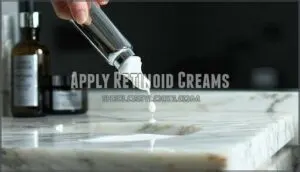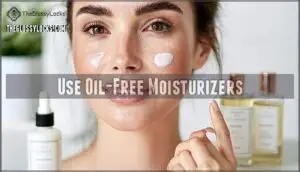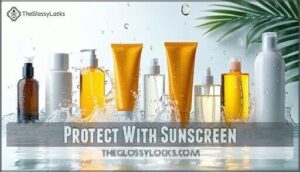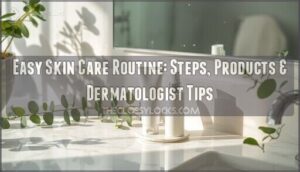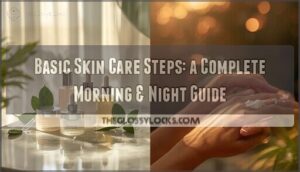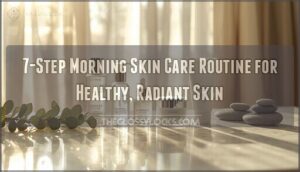This site is supported by our readers. We may earn a commission, at no cost to you, if you purchase through links.
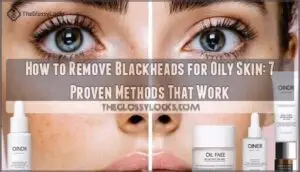 Learning how to remove blackheads for oily skin starts with understanding your skin’s oily nature works against you.
Learning how to remove blackheads for oily skin starts with understanding your skin’s oily nature works against you.
You’ll need salicylic acid products that penetrate deep into clogged pores, breaking down the oil and dead skin cells that create those stubborn dark spots.
Use a gentle, non-abrasive cleanser twice daily, then apply retinoid creams at night to speed up cell turnover.
Don’t skip moisturizer – choose oil-free formulas that won’t clog pores.
Chemical peels once weekly help dissolve buildup without harsh scrubbing.
Always protect with broad-spectrum sunscreen, as some treatments increase sun sensitivity.
The secret lies in finding the right combination of ingredients that work together, using the right products and treatments, such as chemical peels, to achieve the desired results.
Table Of Contents
- Key Takeaways
- How to Remove Blackheads for Oily Skin?
- Use Salicylic Acid
- Apply Retinoid Creams
- Try Chemical Peels
- Use Non-Abrasive Cleansers
- Use Oil-Free Moisturizers
- Protect With Sunscreen
- Frequently Asked Questions (FAQs)
- How do I get rid of blackheads on my face?
- How to get rid of Blackheads naturally?
- Can exfoliation remove Blackheads?
- What moisturizer should I use if I have Blackheads?
- How to get rid of Blackheads without stripping skin?
- Can you extract your own Blackheads?
- How do you get rid of blackheads on oily skin?
- Can oily skin cause blackheads?
- How to treat an oily nose with blackheads?
- What pulls blackheads out immediately?
- Conclusion
Key Takeaways
- You’ll need salicylic acid products that penetrate deep into clogged pores to break down the oil and dead skin cells causing blackheads on oily skin.
- Don’t skip moisturizer – choose oil-free, noncomedogenic formulas that hydrate without clogging pores or triggering more breakouts.
- Use retinoid creams at night to speed up cell turnover and unclog pores, but start with lower concentrations to build tolerance and avoid irritation.
- Protect your skin with broad-spectrum sunscreen daily since many blackhead treatments increase sun sensitivity and UV rays can worsen existing blackheads.
How to Remove Blackheads for Oily Skin?
Dealing with oily skin blackheads feels like fighting an uphill battle, but you’ve got several proven weapons in your arsenal.
Salicylic acid penetrates deep into pores, dissolving the oil and dead skin that create those stubborn spots. Clay masks draw out excess oil while pore strips provide quick satisfaction for surface blackheads.
Natural options like green tea and turmeric masks offer gentle anti-inflammatory benefits. For deeper blackhead removal, consider microdermabrasion treatments that resurface your skin.
Consistent use of noncomedogenic moisturizers can also help. The key to effective oily skin care isn’t just removing existing blackheads—it’s preventing new ones from forming through consistent, targeted treatment.
Use Salicylic Acid
Salicylic acid acts like a deep-cleaning agent for your pores, dissolving the oil and dead skin that create blackheads.
Think of salicylic acid as your pore’s personal cleaning crew, breaking down the gunk that clogs your skin.
This beta hydroxy acid penetrates deeper than surface treatments, making it ideal for oily skin blackheads. Start with 2% acid concentrations in cleansers or toners for effective blackhead removal.
Patch testing prevents surprises – apply a small amount behind your ear first. Various product types offer flexibility, from daily cleansers to spot treatments.
As a desmolytic and keratolytic agent, it disrupts cellular junctions and breaks down keratin. Begin with once-daily usage frequency to avoid irritation management issues while achieving clear oily skin care.
Apply Retinoid Creams
Retinoids pack a serious punch against stubborn blackheads on oily skin.
These vitamin A derivatives boost skin renewal by increasing cell turnover and unclogging pores.
Prescription retinoids offer stronger concentrations than over-the-counter options, making them ideal for persistent acne treatment.
Tretinoin minimizes pore size by directly reducing sebum.
Here’s how to maximize retinoid effectiveness:
- Start with night application – Apply a pea-sized amount before bedtime to avoid breaking down from light exposure
- Choose appropriate retinoid strength – Begin with lower concentrations to minimize irritation while building tolerance
- Manage sun sensitivity – Always use broad-spectrum sunscreen daily since retinoids increase UV vulnerability
Consistent use transforms your skincare routine.
Try Chemical Peels
Chemical peels offer targeted blackhead removal through controlled skin exfoliation. These acid-based treatments dissolve dead skin cells and clear clogged pores effectively. Salicylic acid peels work exceptionally well for oily skin, penetrating deep to break down stubborn blackheads.
Many also seek chemical peels as laser skin rejuvenation becomes a popular alternative.
| Peel Type | Strength Options | Best For |
|---|---|---|
| Salicylic Acid | 10%, 20%, 30% | Oily skin, blackheads |
| Glycolic Acid | 2-10% AHA | Surface exfoliation |
| Professional Peels | Variable concentrations | Stubborn cases |
| Home Peels | Lower concentrations | Regular maintenance |
Start with lower acid types to minimize peel risks. Professional peels deliver intensive results, while home peels provide convenient maintenance.
Use Non-Abrasive Cleansers
While chemical peels work wonders for stubborn blackheads, your daily cleansing routine forms the foundation of clear skin.
Nonabrasive cleaners protect your skin from irritation while effectively tackling clogged pores. Gentle exfoliation through fingertip application prevents the harsh scrubbing that triggers excess oil production in oily skin.
Smart product selection makes all the difference when choosing your facial cleanser:
- Look for alcohol-free formulas that won’t strip natural oils
- Choose cleansers with salicylic acid for pore penetration
- Avoid harsh scrubbing motions that worsen skin irritation
- Select oil-control ingredients that balance sebum production
- Pick gentle formulations designed specifically for acne-prone skin
These cleansers remove blackheads without the aggressive approach that backfires on sensitive, oily complexions. Many find that fragrance-free options minimize irritation.
Use Oil-Free Moisturizers
Your freshly cleansed skin needs proper hydration to maintain its protective barrier. Oil-free moisturizers are game-changers for oily skin prone to blackheads. These lightweight formulas won’t clog pores or trigger breakouts like heavy creams can.
Oil-free moisturizers are your oily skin’s best friend—hydrating without the heavy, pore-clogging mess that triggers more blackheads.
Look for noncomedogenic products containing hyaluronic acid or glycerin – these ingredients provide essential moisture without adding grease. Ingredient analysis matters: avoid fragrances, waxes, and heavy oils that can irritate skin.
Application techniques are simple: gently pat onto clean skin twice daily. Product recommendations include Aveeno Clear Complexion and Peach & Lily moisturizers for ideal hydration importance. Some find that explicit non-comedogenic labeling helps them choose the right product.
Protect With Sunscreen
After sorting your moisturizer routine, you’ll need solid sun protection for your oily skin.
UV rays worsen blackheads and darken acne scars. Choose noncomedogenic sunscreens that won’t clog pores.
Look for zinc oxide and titanium oxide – these sunscreen ingredients work best for acne-prone skin. Skip fragranced formulas that trigger breakouts.
Daily application matters, but so does reapplication frequency – every two hours keeps you covered.
To guarantee adequate defense, consider broad-spectrum protection against both UVA and UVB rays.
Non-comedogenic formulas protect without the greasy mess that makes your skin rebel.
Frequently Asked Questions (FAQs)
How do I get rid of blackheads on my face?
Studies show 85% of people get blackheads by age
You’ll want to use salicylic acid cleansers daily, try clay masks weekly, and consider professional extractions.
Don’t squeeze them yourself—you’ll risk scarring and spreading bacteria.
How to get rid of Blackheads naturally?
Try green tea masks with honey, turmeric paste with water, or egg white mixed with lemon juice.
These natural remedies help draw out oils and dead skin cells from your pores without harsh chemicals.
Can exfoliation remove Blackheads?
Looking for a simple way to clear those stubborn pores?
Yes, exfoliation can remove blackheads by sloughing off dead skin cells and unclogging pores.
You’ll see results with gentle scrubs or chemical exfoliants like salicylic acid.
What moisturizer should I use if I have Blackheads?
Choose noncomedogenic moisturizers that won’t clog your pores.
Look for lightweight, oil-free formulas containing salicylic acid or hyaluronic acid.
These ingredients hydrate skin while preventing blackhead formation and keeping your complexion clear.
How to get rid of Blackheads without stripping skin?
Gentle salicylic acid cleansers won’t strip your skin while dissolving blackheads.
Use 5-2% concentrations every other day, follow with alcohol-free moisturizer.
Choose noncomedogenic products to keep pores clear without over-drying.
Can you extract your own Blackheads?
You can extract your own blackheads, but it’s risky business.
Professional extraction uses specialized tools and proper technique.
Home extraction often leads to scarring, infection, and deeper pore damage, making the problem worse.
How do you get rid of blackheads on oily skin?
Think blackheads disappear with harsh scrubbing? That’s backwards.
You’ll need salicylic acid cleansers daily, clay masks weekly, and noncomedogenic products.
Don’t squeeze them yourself—you’ll create scars and spread bacteria around your face, which can lead to more bacteria.
Can oily skin cause blackheads?
Yes, your oily skin directly contributes to blackhead formation.
Excess sebum production clogs pores with dead skin cells, creating the perfect breeding ground for those stubborn dark spots you’re constantly battling.
How to treat an oily nose with blackheads?
Use salicylic acid cleansers daily on your nose to dissolve oil and dead skin cells.
Apply clay masks twice weekly to absorb excess sebum.
Always choose noncomedogenic products and avoid touching your nose throughout the day.
What pulls blackheads out immediately?
Professional extraction tools and pore strips can pull blackheads out immediately, but they’re risky.
Clay masks with bentonite or kaolin offer safer instant results by drawing out impurities.
You’ll see clearer pores within minutes, which can be achieved with these safer methods.
Conclusion
Managing blackheads is like tending a garden – consistent care yields the best results.
You’ve learned how to remove blackheads for oily skin through seven proven methods: salicylic acid, retinoids, chemical peels, gentle cleansers, oil-free moisturizers, and sunscreen protection.
Remember, patience is key.
Your skin won’t transform overnight, but with regular application of these techniques, you’ll see clearer pores within weeks.
Stick to your routine, and don’t over-treat your skin to avoid irritation.
- https://www.aad.org/public/everyday-care/skin-care-basics/dry/oily-skin
- https://www.epiphanydermatology.com/acne/dermatologists-guide-getting-rid-blackheads/
- https://www.medicalnewstoday.com/articles/how-to-get-rid-of-blackheads
- https://www.healthline.com/health/how-to-prevent-blackheads
- https://wexnermedical.osu.edu/find-a-doctor/susan-massick-md-4575

